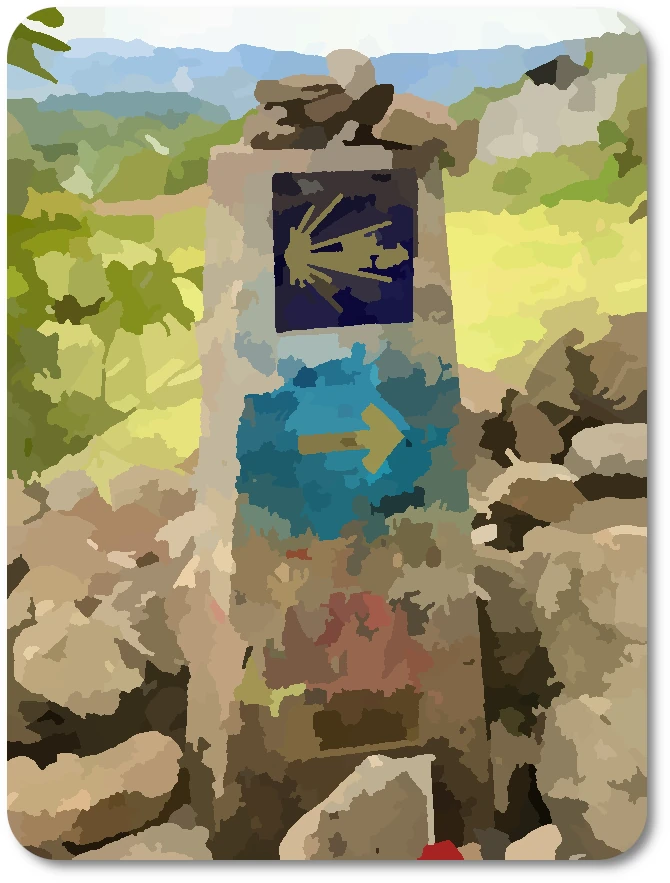- Rosary
- spiritual meditation
- Contemplative Arts
- Stone Dream in Time
Stone Dream in Time
Stone 11
Stone Dream in Time
"Compostela, a stone dream in time "
Salvador Garcia-Bodanos

The meaning of the poem seems to be a reflection on the timeless, enduring nature of Compostela.
A beautiful place that has been a site of spiritual contemplation and pilgrimage for centuries.
The reference to "stone" suggest the permanence and solidity of this historic location, while "dream in time" evokes the sense of Compostela as a place that transcends the ordinary flow of time, offering a space for deeper reflection and connection.
Salvador Garcia Bodanos - Author
Salvador Garcia Bodanos (1935-2023) was a prominent Galician poet. He was a member of the Real Academia Galega (Royal Galician Academy) since 1992. He was recognized for his poetry particularly "Tempo de Compostela", was awarded the prestigious Premio da Critica de Poesia Galega.
A Stone in Dream

For my readers who are deepening their faith and spiritual journey, this poem can be interpreted as a reflection on the ability of sacred contemplation, connection, and a sense of the divine that transcends the ordinary flow of time.
The "Stone" imagery suggests the solidity and permanence of the spiritual truths and experiences that pilgrims seek at Compostela, while the "dream in time" speaks to the transformative, almost mystical quality of the pilgrimage journey.
So, we may ask ourselves, in what ways can the act of pilgrimage, such as walking the Camino de Santiago to Compostela, serve as a transformative spiritual experience?
Many times, I personally have pondered this idea but I'm not sure if I could sustain the physical.
What role do sacred sites like the Cathedral of Santiago de Compostela play in the lives of the faithful? How do they provide a space for contemplation, connection and a deeper experience of the divine?
While I was standing in the courtyard in front of the Cathedral, I could sense the high energy of a finishing point for many that were coming to the end of their walking journey's. Some just sitting down, some jumping with joy of accomplishment and others taking that final selfie in front of the Cathedral with walking sticks in hand.
Being inside the Cathedral to witness the awesomeness of the Cathedral. Saint James did not skimp on anything. It was a beautiful moment to sit with so many people from around the world and to experience the Mass.
A Sensory Experience

The Botafumeiro is a massive incense burner used in the Santiago de Compostela Cathedral in Spain.
This is truly an extraordinary example of liturgical art and tradition.
Let me give you some details about the Botafumeiro, just to give you a visual idea of this.
It is enormous! Weighing around 80 kilograms (175 pounds) and measuring 1/6 meters (5.2 feet) tall, it's one of the largest censers in the world.
Constructed of silver-plated brass, it has a majestic appearance.
The swinging mechanism is suspended from the dome of the cathedral by a complex system of pulleys.
Eight men known as "tiraboleiros," operate the ropes, swinging the censer back and forth with incredible force.
It can reach speeds of up to 60 kilometers per hour (37 miles per hours).
Witnessing the Botafumeiro in action is a truly awe-inspiring sight and sound. The swinging motion is mesmerizing, and the clouds of incense fill the cathedral with a fragrant aroma. I hope to be able to post my video of this experience soon!
In what ways can the poetic verse about Compostela inspire deeper reflection on one's own faith journey? How might it encourage you to consider the transformative potential of engaging in your own spiritual pilgrimage, whether physical or metaphorical?
How does the enduring significance and legacy of Compostela, as a site of pilgrimage for centuries speak to the timeless power of the human search for spiritual meaning?
How do you reflect on "A Stone Dream in Time"?
Walking the Camino

If you decide you will walk the Camino keep in mind that you can reflect the spiritual practices of the Rosary and the Stations of the Cross.
It can be seen as a physical and spiritual journey that mirrors the reflective practices of the Rosary and the Stations of the Cross.
Just as the Rosary guides the faithful through a series of prayers and meditations, the Camino provides pilgrims with a structured path to follow. Each step along the way becomes an opportunity for contemplation and connection with the divine.
Just as one bead on the Rosary leads to the next, each kilometer walked on the Camino can represent a new stage of the journey, both outward and inward.
Similarly, the Stations of the Cross, which recount the final moments of Jesus' life, can find parallels in the Camino. As pilgrims make their way to the cathedral, they may pause at designated spots to reflect on the struggles and triumphs of the journey, much like the faithful who meditate on the Stations.
Each challenge faced, each hill climbed, can become a modern-day "Station" that invites the pilgrim to deepen their faith and find meaning in the experience.
Ultimately, the Camino de Santiago is a pilgrimage that engages the body, mind, and spirit.
Like the Rosary and the Stations of the Cross, it provides a structured path for the faithful to follow, allowing them to connect with their deepest beliefs and find a sense of purpose and renewal in their spiritual lives.
The physical act of walking becomes a metaphor for the inner journey of the soul.
















